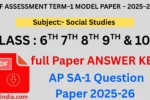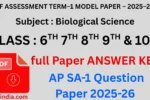Class 10 – Biological Science Self-Assessment Model Paper – I
(2025-26)
Time: 1 hour
Maximum Marks: 35
Part – A (Multiple Choice Questions – MCQs)
(Each question carries 1 mark)
- Which of the following is the primary site of respiration in the human body?
a) Heart
b) Lungs
c) Liver
d) Kidneys - Which of the following is the main function of the human excretory system?
a) Digestion of food
b) Removal of waste products
c) Regulation of body temperature
d) Transport of nutrients - The process by which plants make their food is called:
a) Respiration
b) Photosynthesis
c) Transpiration
d) Digestion - Which part of the human digestive system is responsible for the absorption of nutrients?
a) Stomach
b) Small intestine
c) Large intestine
d) Esophagus - Which of the following is the correct path of blood circulation in the human body?
a) Heart → Lungs → Body → Heart
b) Lungs → Heart → Body → Lungs
c) Heart → Body → Lungs → Heart
d) Body → Heart → Lungs → Body - The function of chloroplasts in plant cells is to:
a) Store nutrients
b) Carry out photosynthesis
c) Synthesize proteins
d) Transport water - Which of the following is NOT a part of the human circulatory system?
a) Arteries
b) Veins
c) Capillaries
d) Lungs - Which of the following is a product of anaerobic respiration in yeast?
a) Lactic acid
b) Ethanol and carbon dioxide
c) Oxygen
d) Glucose - The primary function of the root system in plants is to:
a) Synthesize food
b) Absorb water and minerals
c) Transport food
d) Protect the plant - Which enzyme is responsible for the digestion of starch in the human body?
a) Pepsin
b) Amylase
c) Trypsin
d) Lipase
Part – B (Very Short Answer Questions – VSAQ)
(Each question carries 2 marks)
- What is the role of the large intestine in the human digestive system?
- Explain the process of transpiration in plants.
- Name the two types of circulatory systems found in living organisms.
Part – C (Short Answer Questions – SAQ)
(Each question carries 4 marks)
- Describe the process of photosynthesis in plants.
- Explain the structure and function of human kidneys.
- What is the role of enzymes in the digestion of food? Give examples.
Part – D (Long Answer Question – Essay)
(1 question – 8 marks)
Discuss the process of digestion in humans. Explain the roles of different organs involved, including the mouth, stomach, small intestine, and accessory organs like the liver and pancreas.
Answer Key
Part – A (MCQ):
- b) Lungs
- b) Removal of waste products
- b) Photosynthesis
- b) Small intestine
- a) Heart → Lungs → Body → Heart
- b) Carry out photosynthesis
- d) Lungs
- b) Ethanol and carbon dioxide
- b) Absorb water and minerals
- b) Amylase
Part – B (VSAQ):
- The large intestine absorbs water and salts from the material that has not been digested in the small intestine. It also stores the remaining waste before it is expelled from the body.
- Transpiration is the process by which water is absorbed by plant roots from the soil and then lost as water vapor through stomata in the leaves. It helps in the cooling of plants and the upward movement of water and minerals.
- The two types of circulatory systems are:
- Open circulatory system: Found in arthropods and mollusks.
- Closed circulatory system: Found in humans and other vertebrates.
Part – C (SAQ):
- Photosynthesis is the process by which green plants synthesize food using carbon dioxide, water, and sunlight, with the help of chlorophyll. The general equation is: 6CO2+6H2O+light energy→C6H12O6+6O26CO_2 + 6H_2O + light \, energy \to C_6H_{12}O_6 + 6O_2 This process occurs in the chloroplasts of plant cells.
- The kidneys are paired organs located in the abdomen. They filter blood to remove waste products, regulate water and electrolyte balance, and produce urine. The functional unit of the kidney is the nephron.
- Enzymes are biological catalysts that speed up the process of digestion. For example, amylase breaks down starch into simple sugars, pepsin breaks down proteins in the stomach, and lipase breaks down fats into fatty acids and glycerol.
Part – D (Essay):
- Digestion in Humans:
The process of digestion begins in the mouth, where the food is mechanically broken down by chewing and mixed with saliva, which contains the enzyme amylase. This enzyme starts the digestion of starch.
The food then moves to the stomach, where it is mixed with gastric juices that contain pepsin, an enzyme that digests proteins. The stomach’s acidic environment also helps break down food.
In the small intestine, bile from the liver and enzymes from the pancreas further break down the food into nutrients, which are absorbed into the bloodstream.
The large intestine absorbs excess water, and the remaining waste is prepared for excretion.
Here’s a Class 10 Physical Science Self-Assessment Question Paper based on the 2025-2026 syllabus, focusing on the topics of Force, Motion, Work and Energy, and related concepts.
Class 10 – Physical Science Self-Assessment Model Paper – I
(2025-26)
Time: 1 hour
Maximum Marks: 35
Part – A (Multiple Choice Questions – MCQs)
(Each question carries 1 mark)
- What is the SI unit of work?
a) Watt
b) Joule
c) Newton
d) Meter - The acceleration due to gravity on Earth is approximately:
a) 9.8 m/s²
b) 10 m/s²
c) 8.9 m/s²
d) 9.8 cm/s² - When a force is applied to an object and it moves in the direction of the force, the work done is:
a) Zero
b) Positive
c) Negative
d) Uncertain - The unit of power is:
a) Joule
b) Newton
c) Watt
d) Meter - Which of the following is a vector quantity?
a) Speed
b) Distance
c) Displacement
d) Time - What is the formula for calculating kinetic energy?
a) KE=12mvKE = \frac{1}{2} mv
b) KE=12mv2KE = \frac{1}{2} m v^2
c) KE=mghKE = mgh
d) KE=12mv3KE = \frac{1}{2} m v^3 - If an object is moving with a constant velocity, then the net force acting on it is:
a) Zero
b) Equal to the object’s mass
c) Equal to the object’s weight
d) Non-zero - Which of the following is the correct equation for work done?
a) W=F×tW = F \times t
b) W=F×dW = F \times d
c) W=FdW = \frac{F}{d}
d) W=F×vW = F \times v - A body is said to be in motion when it:
a) Changes its speed
b) Changes its position
c) Changes its velocity
d) None of the above - Energy possessed by a body due to its position is called:
a) Kinetic energy
b) Potential energy
c) Mechanical energy
d) Thermal energy
Part – B (Very Short Answer Questions – VSAQ)
(Each question carries 2 marks)
- Define work and write its SI unit.
- What is the relationship between force and acceleration according to Newton’s second law of motion?
- State the law of conservation of energy.
Part – C (Short Answer Questions – SAQ)
(Each question carries 4 marks)
- Explain the difference between speed and velocity with an example.
- Derive the formula for the work done by a force.
- How is power related to work and time? Derive the equation for power.
Part – D (Long Answer Question – Essay)
(1 question – 8 marks)
Explain Newton’s three laws of motion and their applications in everyday life. Discuss with examples.
Answer Key
Part – A (MCQ):
- b) Joule
- a) 9.8 m/s²
- b) Positive
- c) Watt
- c) Displacement
- b) KE=12mv2KE = \frac{1}{2} m v^2
- a) Zero
- b) W=F×dW = F \times d
- b) Changes its position
- b) Potential energy
Part – B (VSAQ):
- Work is done when a force causes a displacement of an object in the direction of the force. Its SI unit is Joule (J).
- According to Newton’s second law of motion, Force (FF) is directly proportional to the acceleration (aa) of an object and its mass (mm), i.e., F=maF = ma.
- Law of conservation of energy states that energy cannot be created or destroyed; it can only be converted from one form to another. The total energy in a closed system remains constant.
Part – C (SAQ):
- Speed is the distance traveled per unit of time, while velocity is the displacement per unit of time. For example, if a car travels 100 meters in 5 seconds, its speed is 20 m/s, but if it travels 100 meters east, its velocity is 20 m/s towards the east.
- Work done by a force is given by the equation:
W=F×d×cos(θ)W = F \times d \times \cos(\theta)
where WW is work, FF is the force, dd is the displacement, and θ\theta is the angle between the force and displacement. If the force and displacement are in the same direction, θ=0∘\theta = 0^\circ and cos(0∘)=1\cos(0^\circ) = 1, simplifying to W=F×dW = F \times d. - Power is the rate at which work is done or energy is transferred. The formula for power is:
P=WtP = \frac{W}{t}
where PP is power, WW is work done, and tt is time taken. The unit of power is Watt (W), and one watt is equivalent to one joule per second.
Part – D (Essay):
- Newton’s Three Laws of Motion:
- First Law (Law of Inertia): An object at rest will stay at rest, and an object in motion will stay in motion unless acted upon by an external force.
- Example: A book on a table will not move unless you push it.
- Second Law (F = ma): The force acting on an object is equal to the mass of the object multiplied by its acceleration.
- Example: Pushing a lighter object will cause more acceleration than pushing a heavier object with the same force.
- Third Law (Action and Reaction): For every action, there is an equal and opposite reaction.
- Example: When you push a wall, the wall pushes back with an equal force.
- First Law (Law of Inertia): An object at rest will stay at rest, and an object in motion will stay in motion unless acted upon by an external force.


1 thought on “class 10th ps & ns Biological Physical Science Self Assessment fa 1 Question Paper 2025-26 with answer keys”
Comments are closed.